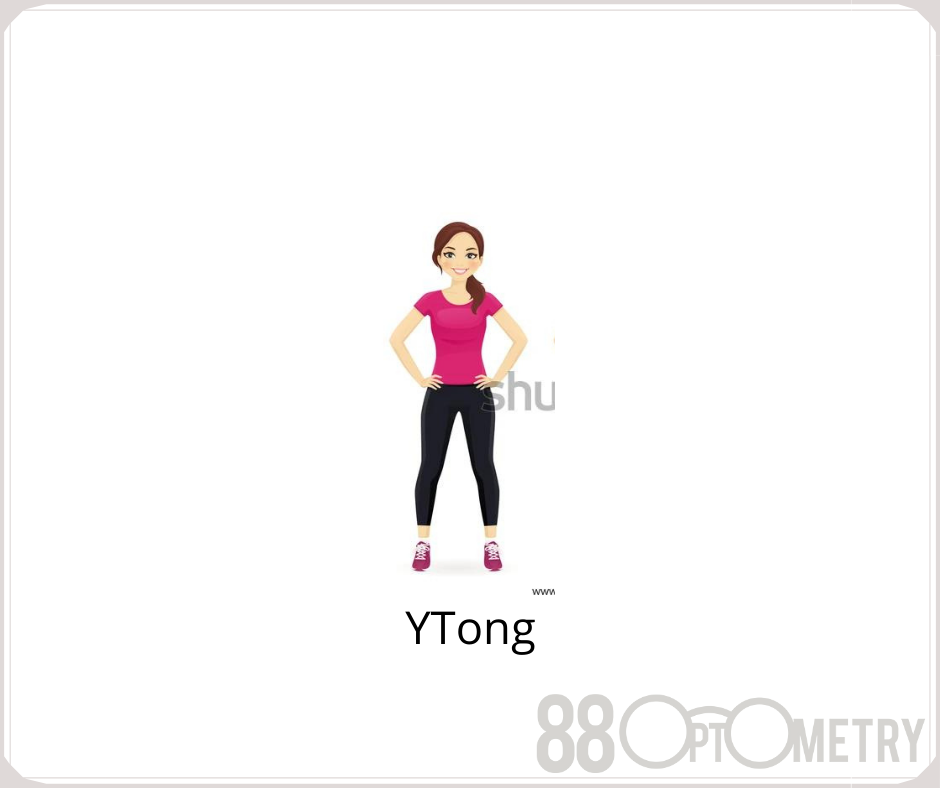YTong (F/23), YCheng’s sis came for eye examination, she wears her existing glasses for driving & computer work only. Vision is fine seeing far & near with her glasses. She occasionally finds that her eyes are dry especially during computer work.
Vision without glasses
R: 6/60-2
L: 6/7.5
Vision with existing glasses
R: -3.00 (+1.00 blur lens test 6/12)
L: -1.25 (+1.00 blur lens test 6/7.5)
Examination shows:
R: -2.75 (6/6)
L: -0.50 (6/6) L>R [L: dominant left eye]
Other assessments show:
Examination of Eye Alignment/Vergence (Cover Test)
NMD @ Distance
small XP, fast to moderate recovery @ Near
(normal value: orthophoria/NMD-No Movement Detected or small XP, fast recovery)
EP = Esophoria is misalignment of the eye, eye is deviated inwards
XP = Exophoria is misalignment of the eye, eye is deviated outwards
Examination of Eye Alignment/Posture (Howell Card) by 6^ Base Down on Right eye
Distance: 2 – 4 EP (blue part)
Near: 10 – 12 EP (blue part)
+1.00 Near: 12 – 14 EP (blue part)
(normal value: 0-1 EP or 0-3 XP @Distance and 0-6 XP @Near)
EP = Esophoria is misalignment of the eye, eye is deviated inwards
XP = Exophoria is misalignment of the eye, eye is deviated outwards
Fusional Reserves (Convergent/Divergent reserve stamina) by Prism Bar
Near, Base-Out/Convergent, PFV: 18/35/18
Near, Base-In/Divergent, NFV: 20/30/14
(normal value: Blur/Break/Recovery)
Near, PFV: 16/10-28/7-21
Near, NFV: 13/7-19/5-15
[Scheiman – Adult Data]
AA (Accommodation/Focusing – eye stamina/ability of eye to focus & sustain seeing near clearly) by RAF rule
R: AA of 33 YO
L: AA of 25 YO
(normal value: AA goes according to your age)
NPC (Convergence – ability of eye to maintain a single clear near image) by RAF rule
9cm, 9cm, 9cm
(normal value: less than 10cm)
YTong has anisometropia, different power of at least 200 in between both eyes. Her mother has anisometropia too, so she takes after her mother. Both mother & Tong attain good optimum vision in the eye with higher short-sightedness/myopia, as they wear glasses when driving – in which this highly myopic eye still gets clear vision at certain time every day.
Comparatively, if they were not wearing glasses at all (since the other eye has pretty good vision), the high myopic eye most likely would have lazy eye/amblyopia due to vision deprivation/not seeing clear target. After years of seeing blurry, eye will develop amblyopia.. this is typically detected during primary school years.
The moment a child has refractive error/power, he/she should be wearing optimum power as prescribed with regular follow up by the optometrist. Ensuring clear, optimum vision is the first step.. controlling the power progression throughout studies will be the ultimate goal.
YTong has mild PEE/dry eye in which we prescribe non-preserved gel artificial tears. She came back about 3 weeks later and the dry spots have fully resolved. Her Tears Break Up Time (TBUT) is low at 2seconds, indicative of evaporative dry eyes.. she needs to take food rich in omega 3 to optimise oil/lipid layer on the surface of eyes (dietary) or to replenish the lipid layer using certain type of artificial tears (eye drop) when she feels that her eyes are dry.
Planning to wear contact lens now.. we have given her tutorial in lens insertion & removal. Significant exophoria at near is noted, we will let her wear contact lens for some time while allowing eyes to always be fully corrected and reassess her eye alignment again.
Getting annual eye examination & wearing your optimum correction are the things that you can do to pamper your eyes. Only when our eyes are seeing optimally with power fully corrected, will they be able to relaxingly do their job (ie convergence & accommodation) in fulfilling our vision needs.

